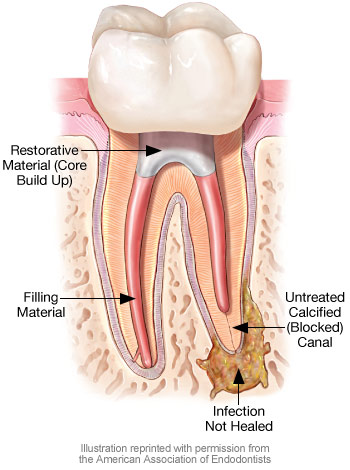Endodontic Retreatment: Why and When It’s Necessary
Have you ever experienced a persistent toothache that just won’t go away, despite having previously undergone a root canal treatment? It can be frustrating and concerning when this happens, but fear not, because there is a solution.
Endodontic retreatment, a procedure aimed at addressing failed root canal treatments, may be necessary in such cases. But why does this happen, and when is retreatment needed?
In this discussion, we will explore the common reasons for endodontic retreatment, the signs that indicate its necessity, and the factors that contribute to the failure of previous root canal treatments.
So, let’s uncover the mysteries behind this dental procedure and discover the importance of timely retreatment in preserving your tooth health.
Common Reasons for Endodontic Retreatment
One common reason for needing endodontic retreatment is if the initial root canal treatment didn’t fully resolve the infection. If you have undergone a root canal procedure but are still experiencing pain or discomfort in the treated tooth, it’s possible that the infection wasn’t completely eliminated. This can occur due to various factors, such as missed canals, complex anatomy of the tooth, or the presence of curved or calcified canals that were difficult to clean and shape during the initial treatment.
Another reason for endodontic retreatment is if there’s a new infection or decay in the tooth. Over time, teeth can become reinfected if bacteria enter the root canal system through a new cavity or a crack in the tooth. This can lead to symptoms such as pain, swelling, or the formation of an abscess. In such cases, retreatment is necessary to remove the source of infection and prevent further damage to the tooth and surrounding tissues.
In addition, if a crown or filling placed after the initial root canal treatment becomes loose or damaged, retreatment may be required. A compromised restoration can allow bacteria to enter the tooth and cause reinfection. Therefore, it’s important to maintain proper oral hygiene and regularly visit your dentist to ensure the long-term success of your root canal treatment.
Signs and Symptoms That Indicate the Need for Retreatment
If you’re experiencing persistent pain or swelling in a tooth that has already undergone root canal treatment, it may be a sign that retreatment is necessary. While some discomfort immediately after the procedure is normal, ongoing pain or swelling could indicate an issue that requires further attention. Here are some signs and symptoms that may indicate the need for retreatment:
– Recurring or new pain: If you start experiencing pain in a tooth that was previously treated, it could be a sign of reinfection or an unresolved issue.
– Swelling or tenderness: Swelling around the affected tooth, along with tenderness to touch, may suggest an infection or abscess.
– Sensitivity to heat or cold: Increased sensitivity to temperature changes in the treated tooth can be a sign of an underlying problem.
– Gum pimples or fistulas: These are small pimple-like bumps that appear on the gum near the treated tooth, indicating the presence of infection.
– Radiographic changes: X-rays that show new or persistent signs of infection, such as bone loss or widening of the root canal space, may indicate the need for retreatment.
If you’re experiencing any of these symptoms, it’s important to consult with your dentist or endodontist as soon as possible. They’ll be able to evaluate your situation and determine if retreatment is necessary to address the underlying issue and alleviate your discomfort.
Factors That Contribute to the Failure of Previous Root Canal Treatment
Several factors can contribute to the failure of previous root canal treatment. One common factor is inadequate cleaning and shaping of the root canal system. When the canals aren’t thoroughly cleaned and shaped, bacteria and debris can remain, leading to reinfection and treatment failure.
Another factor is the presence of untreated or missed canals. If all the canals aren’t identified and treated during the initial root canal procedure, the untreated canals can harbor bacteria and cause persistent infection. Additionally, poorly sealed or leaking restorations can allow bacteria to recontaminate the root canal system, leading to failure of the previous treatment.
Other factors that can contribute to treatment failure include dental trauma or fractures, which can result in reinfection of the root canal system. In some cases, the original root canal treatment may have been performed on a tooth with complex anatomy or unusual canal configurations, making it difficult to completely clean and fill the canals.
Lastly, patient compliance and oral hygiene practices play a significant role in the success of root canal treatment. Failure to maintain good oral hygiene and attend regular dental check-ups can increase the risk of reinfection and subsequent treatment failure.
It is essential to address these factors when considering endodontic retreatment. By identifying and addressing the underlying causes of treatment failure, it’s possible to improve the long-term success of root canal therapy.
The Importance of Timely Retreatment in Preserving Tooth Health
To preserve the health of your tooth, timely retreatment is imperative. When it comes to endodontic retreatment, acting promptly can make a significant difference in preserving your tooth and avoiding further complications.
Here are five reasons why timely retreatment is crucial:
– Preventing infection: Timely retreatment can help prevent the spread of infection to other areas of the tooth or surrounding tissues. By addressing the issue promptly, you minimize the risk of further complications.
– Saving the tooth: Retreatment can often save your tooth from extraction. By removing the infection and properly sealing the canals, retreatment allows for the preservation of your natural tooth structure.
– Relieving pain: If you’re experiencing persistent pain or discomfort following a root canal treatment, timely retreatment can provide relief. By addressing any residual infection or inflammation, retreatment can alleviate your symptoms.
– Avoiding complications: Leaving a failing root canal untreated can lead to complications such as abscesses, cysts, or damage to adjacent teeth. Timely retreatment can help prevent these issues from occurring.
– Cost-effectiveness: By addressing the need for retreatment sooner rather than later, you can potentially avoid more extensive and expensive dental procedures in the future.
Understanding the Process of Endodontic Retreatment
Understanding the process of endodontic retreatment is essential for patients who may need to undergo this procedure. Endodontic retreatment is a dental procedure performed when a tooth that has previously undergone root canal treatment requires further intervention. The goal of retreatment is to address any issues that may have arisen after the initial treatment, such as persistent infection or inadequate healing.

The process of endodontic retreatment typically involves several steps. First, the dentist will assess the tooth and review any previous treatment records and X-rays. This evaluation helps in identifying the cause of the problem and determining the best course of action.
Next, local anesthesia is administered to numb the area, ensuring a comfortable experience. After the tooth is numb, the dentist will access the root canal system by removing any existing restorations or fillings. This allows them to clean and disinfect the canals thoroughly. The dentist will use specialized tools to remove any infected or damaged tissue and carefully clean the entire root canal system. They may also use digital imaging to aid in identifying any complex anatomical features or missed canals.
Once the canals are clean, the dentist will fill them with a biocompatible material called gutta-percha. This material seals the canals, preventing reinfection. Finally, the tooth is restored with a filling or crown to protect and strengthen it.
Understanding the process of endodontic retreatment can help alleviate any concerns or anxieties you may have about the procedure. It’s essential to consult with your dentist to determine if retreatment is necessary and to receive personalized care and guidance throughout the process.
Frequently Asked Questions
Can Endodontic Retreatment Be Avoided if I Take Good Care of My Teeth After the Initial Root Canal Treatment?
If you take good care of your teeth after the initial root canal treatment, endodontic retreatment may be avoided. Proper oral hygiene, such as brushing and flossing regularly, can help maintain the health of your teeth and prevent reinfection.
However, there are certain cases where retreatment may still be necessary, such as if there’s a persistent infection or if the initial treatment wasn’t successful. Regular dental check-ups are important to monitor the condition of your teeth and determine if retreatment is needed.
Are There Any Alternative Treatments Available for Failed Root Canal Treatment, Instead of Retreatment?
There aren’t any alternative treatments available for failed root canal treatment instead of retreatment. When a root canal treatment fails, retreatment is necessary to address the underlying issues and save the tooth.
While taking good care of your teeth after the initial treatment can help prevent complications, sometimes retreatment is unavoidable. It’s important to consult with your dentist or endodontist to determine the best course of action for your specific situation.
How Long Does Endodontic Retreatment Take to Complete?
Endodontic retreatment typically takes a few appointments to complete. The exact duration can vary depending on the complexity of your case.
During the first appointment, your dentist will remove the previous filling material and clean the canals thoroughly. This process may take around one to two hours.
The subsequent appointments will involve filling and sealing the canals with new material.
The overall time for retreatment can range from a few weeks to a couple of months, depending on your specific situation.
Can Endodontic Retreatment Be Done on a Tooth That Has a Crown or Filling?
Yes, endodontic retreatment can be done on a tooth that has a crown or filling. The procedure involves removing the crown or filling to access the root canal system.
Once the root canal is cleaned and disinfected, a new filling material is placed, and the crown or filling is replaced.
This allows for thorough cleaning and treatment of any recurring infection or complications in the root canal, ensuring the long-term health of your tooth.
What Are the Potential Risks or Complications Associated With Endodontic Retreatment?
When it comes to endodontic retreatment, it’s important to understand the potential risks or complications that may arise. Some possible issues include infection, damage to surrounding structures, and the need for additional dental work.
It’s crucial to communicate with your dentist and discuss any concerns or questions you may have. They’ll be able to provide you with the necessary information and guidance to ensure a successful retreatment process.
Conclusion
So, if you’re experiencing persistent pain or swelling around a previously treated tooth, it may be time to consider endodontic retreatment.
By addressing any issues that may have caused the initial root canal treatment to fail, you can preserve the health of your their explanation tooth and avoid further complications.
Don’t hesitate to seek timely retreatment to ensure the best possible outcome for your oral health.
Was this helpful?

Welcome to my website! I am Levi Halpern, a dedicated and passionate professional Cosmetic Dentist with extensive experience in Orthodontic Innovations, Periodontal Care, and Pediatric Dental Care. I am thrilled to have the opportunity to share my knowledge and expertise with you.

